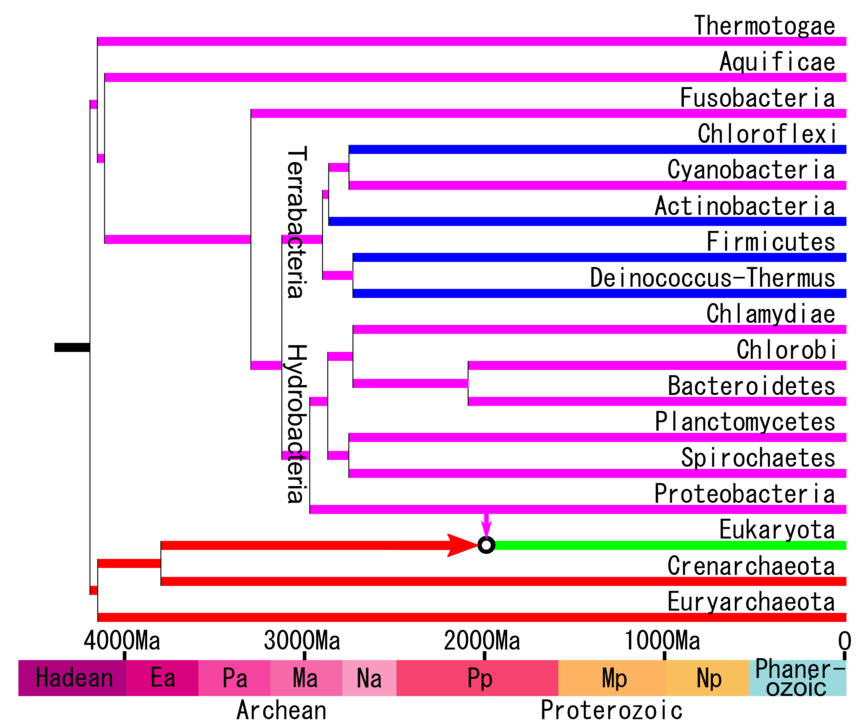| Hydrobacteria | |
|---|---|

| |
| Escherichia coli cells magnified 25,000 times | |
|
Scientific classification
| |
| Domain: | Bacteria |
| Clade: |
Hydrobacteria Battistuzzi and Hedges 2009 [1] |
| Superphyla/Phyla | |
Hydrobacteria is a taxon containing approximately one-third of prokaryote species, mostly gram-negative bacteria and their relatives. [1] It was found to be the closest relative of an even larger group of Bacteria, Terrabacteria, which are mostly gram-positive bacteria. [2] [1] The name Hydrobacteria (hydro = "water") refers to the moist environment inferred for the common ancestor of those species. In contrast, species of Terrabacteria possess adaptations for life on land. [2] [1]
The content of Hydrobacteria has grown to include these superphyla and phyla: Acidobacteriota, Aquificota, Bdellovibrionota, Campylobacterota, Deferribacterota, Dependentiae, Desulfobacterota, Desulfuromonadota, Elusimicrobiota, FCB superphylum, Myxococcota, Nitrospirota, Proteobacteria, PVC superphylum, and Spirochaetota. [3] [4]
Some unrooted molecular phylogenetic analyses [5] [6] have not supported this dichotomy of Terrabacteria and Hydrobacteria, but the most recent genomic analyses, [3] [4] including those that have focused on rooting the tree, [3] have found these two groups to be monophyletic.
Hydrobacteria and Terrabacteria were inferred to have diverged approximately 3 billion years ago, suggesting that land (continents) had been colonized by prokaryotes at that time. [1] Together, Hydrobacteria and Terrabacteria form a large group containing 97% of prokaryotes and 99% of all species of Bacteria known by 2009, and placed in the taxon Selabacteria, in allusion to their phototrophic abilities (selas = light). [7] Currently, the bacterial phyla that are outside of Hydrobacteria + Terrabacteria, and thus justifying the taxon Selabacteria, are debated and may or may not include Fusobacteria. [3] [4]
"Gracilicutes," which was described in 1978 by Gibbons and Murray, [8] is sometimes used in place of Hydrobacteria. However, "Gracilicutes" included cyanobacteria (a member of Terrabacteria) and was not constructed under the now generally accepted three-domain system. [8] More recently, a redefinition of "Gracilicutes" was proposed [9] but it did not include a molecular phylogeny or statistical analyses. Also, it did not follow the three-domain system, claiming instead that the lineage of eukaryotes + Archaea is nested within Bacteria as a close relative of Actinomycetota, a tree not supported in any molecular phylogeny.
Phylogeny
The definition of two major divisions within the domain Bacteria, Hydrobacteria and Terrabacteria, has come largely from rooted phylogenetic analyses of genomes. [2] [1] [3] [4] Unrooted analyses have not fully supported this division, [6] [5] drawing attention to the importance of rooted trees of life.
The two recent analyses of bacterial phylogeny both supported the division of Hydrobacteria and Terrabacteria. [3] [4] However, they interpreted the evolution of the cell wall differently, with one concluding that the last common ancestor of Bacteria was a monoderm ( gram-positive bacteria [3]) and the other concluding that it was a diderm ( gram-negative bacteria [4]). The following tree is redrawn from one of those two recent studies, [3] showing the phylogeny of bacterial phyla and superphyla, with the position of Fusobacteria being unresolved and DST being the closest relative of Terrabacteria:
-
A phylogeny of bacterial phyla and superphyla according to Coleman et al. (2021). [3] Hydrobacteria was referred to as "Gracilicutes" in that study.
References
- ^ a b c d e f g Battistuzzi, F. U.; Hedges, S. B. (1 February 2009). "A Major Clade of Prokaryotes with Ancient Adaptations to Life on Land". Molecular Biology and Evolution. 26 (2): 335–343. doi: 10.1093/molbev/msn247. PMID 18988685.
- ^ a b c d Battistuzzi, Fabia U; Feijao, Andreia; Hedges, S Blair (2004). "A genomic timescale of prokaryote evolution: insights into the origin of methanogenesis, phototrophy, and the colonization of land". BMC Evolutionary Biology. 4 (1): 44. doi: 10.1186/1471-2148-4-44. PMC 533871. PMID 15535883.
- ^ a b c d e f g h i Coleman, Gareth A.; Davín, Adrián A.; Mahendrarajah, Tara A.; Szánthó, Lénárd L.; Spang, Anja; Hugenholtz, Philip; Szöllősi, Gergely J.; Williams, Tom A. (7 May 2021). "A rooted phylogeny resolves early bacterial evolution". Science. 372 (6542): eabe0511. doi: 10.1126/science.abe0511. hdl: 1983/51e9e402-36b7-47a6-91de-32b8cf7320d2. PMID 33958449. S2CID 233872903.
- ^ a b c d e f Léonard, Raphaël R.; Sauvage, Eric; Lupo, Valérian; Perrin, Amandine; Sirjacobs, Damien; Charlier, Paulette; Kerff, Frédéric; Baurain, Denis (18 February 2022). "Was the Last Bacterial Common Ancestor a Monoderm after All?". Genes. 13 (2): 376. doi: 10.3390/genes13020376. PMC 8871954. PMID 35205421.
- ^ a b Hug, Laura A.; Baker, Brett J.; Anantharaman, Karthik; Brown, Christopher T.; Probst, Alexander J.; Castelle, Cindy J.; Butterfield, Cristina N.; Hernsdorf, Alex W.; Amano, Yuki; Ise, Kotaro; Suzuki, Yohey; Dudek, Natasha; Relman, David A.; Finstad, Kari M.; Amundson, Ronald; Thomas, Brian C.; Banfield, Jillian F. (May 2016). "A new view of the tree of life". Nature Microbiology. 1 (5): 16048. doi: 10.1038/nmicrobiol.2016.48. PMID 27572647. S2CID 3833474.
- ^ a b Zhu, Qiyun; Mai, Uyen; Pfeiffer, Wayne; Janssen, Stefan; Asnicar, Francesco; Sanders, Jon G.; Belda-Ferre, Pedro; Al-Ghalith, Gabriel A.; Kopylova, Evguenia; McDonald, Daniel; Kosciolek, Tomasz; Yin, John B.; Huang, Shi; Salam, Nimaichand; Jiao, Jian-Yu; Wu, Zijun; Xu, Zhenjiang Z.; Cantrell, Kalen; Yang, Yimeng; Sayyari, Erfan; Rabiee, Maryam; Morton, James T.; Podell, Sheila; Knights, Dan; Li, Wen-Jun; Huttenhower, Curtis; Segata, Nicola; Smarr, Larry; Mirarab, Siavash; Knight, Rob (December 2019). "Phylogenomics of 10,575 genomes reveals evolutionary proximity between domains Bacteria and Archaea". Nature Communications. 10 (1): 5477. Bibcode: 2019NatCo..10.5477Z. doi: 10.1038/s41467-019-13443-4. PMC 6889312. PMID 31792218.
- ^ Battistuzzi, FU; Hedges, SB (2009). "Eubacteria". In Hedges, SB; Kumar, S (eds.). The Timetree of Life. New York: Oxford University Press. pp. 106–115.
- ^ a b Gibbons, N. E.; Murray, R. G. E. (1 January 1978). "Proposals Concerning the Higher Taxa of Bacteria". International Journal of Systematic Bacteriology. 28 (1): 1–6. doi: 10.1099/00207713-28-1-1.
- ^ Cavalier-Smith, Thomas (2006). "Rooting the tree of life by transition analyses". Biology Direct. 1 (1): 19. doi: 10.1186/1745-6150-1-19. PMC 1586193. PMID 16834776.

![A phylogeny of bacterial phyla and superphyla according to Coleman et al. (2021).[3] Hydrobacteria was referred to as "Gracilicutes" in that study.](https://upload.wikimedia.org/wikipedia/commons/c/ce/Bacterial_phyla_and_superphyla.png)